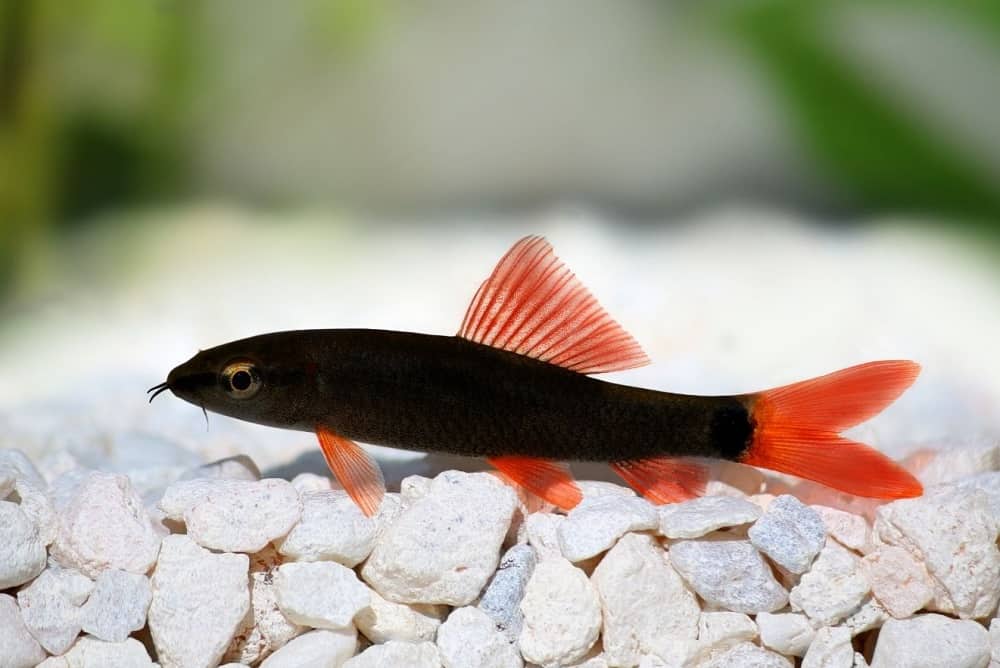The rainbow shark (otherwise known as the red-finned or ruby shark) is a species of fish found in the waters of Southeast Asia, where it is commonly distinguished by its vibrant and unique appearance.
The species is not a saltwater fish and can commonly be found in rivers throughout Malaysia and Thailand, where it will usually thrive in sandy environments with high percentages of plankton.
Despite its namesake, the rainbow shark is not a variety of shark but instead takes its name from its shark-like appearance, with the fish’s red dorsal fin often being used as an indicator to identify the species.

Unlike true sharks, which belong to the Chondrichthyes family, the rainbow shark belongs to the Cyprinidae family, which means it is more closely related to species such as the common minnow.
Once upon a time, rainbow sharks could be found in abundance throughout the rivers of Southeast Asia. However, the population of rainbow sharks has recently begun to decline, with human intervention often being cited as the main reason for the dwindling numbers.
These days, the tropical fish trade has very little impact on the species and its conservation, as almost all commercially available rainbow sharks originate from breeding farms in Thailand.
Care Guide
If you are now interested in purchasing a rainbow shark for your freshwater aquarium, then there are some important things that need to be considered first.
Although rainbow sharks are not fish that need to be constantly monitored, they do require a certain level of care and have essential needs that must be met to ensure their health and longevity.
In the guide below, we are going to outline some key areas that you need to focus on when it comes to caring for your rainbow shark. By following these points, we hope that you will be able to provide your rainbow shark with everything they need to live a long and bountiful life.
Tank Size
Of course, one of the most important things you need to consider is the size of the tank you are going to purchase, as even smaller fish need sufficient space to remain healthy and positive in their enclosures.
When it comes to caring for a rainbow shark, the recommended tank sizes will start at 50 gallons, however, this size will usually increase depending on the number of fish you intend to house.
For this reason, it is recommended that you purchase a tank that measures at least 4-feet long and 18-inches wide, as this will provide your rainbow shark with enough space to remain active and comfortable, while also ensuring that they do not attack any other species in your aquarium.
This particular tank will also provide enough room for you to add various accessories, which can also be beneficial for your other fish.
Tank Mates
In the wild, rainbow sharks can often be found dwelling on the bottom of rivers, which means that the species is known to exhibit the same behaviour in captivity.
Because of this, it is recommended that you avoid placing rainbow sharks in aquariums with other bottom-dwelling fish, as rainbow sharks can be very territorial and may act aggressively towards other species entering their environment.
Species that should be avoided include:
- Bala sharks
- Catfish
- Cichlids
- Red sharks
Instead, you need to invest in freshwater species that prefer to dwell near the top of the aquarium, while also being able to defend themselves from other fish and potential dangers. Fortunately, there is a wide selection of fish that meet this criterion, making them the ideal tank mates for your rainbow shark.
Species that should be considered include:
- Rasboras
- Danios
- Gouramis
- Loaches
- Rainbowfish
Same Species Tanks
Although the practice of keeping multiple rainbow sharks in the same tank is not impossible, it can be extremely difficult. As we have previously mentioned, rainbow sharks are highly territorial creatures, which means they are prone to aggressive behaviour and will often attack other members of their own species.
Because of this, larger rainbow sharks will often try to assert their dominance over smaller specimens in your aquarium, while also singling out other species that resemble themselves in appearance.
For this reason, it is recommended that you only house 5 rainbow sharks in the same tank, for this number will provide the dominant member with more tank mates to bully, while also ensuring that the abuse is not targeted towards a single fish.
Water Parameters
When caring for a rainbow shark, you must make sure that the conditions inside your aquarium replicate their natural habitat. Something that can be easily accomplished through the measurement of temperature, water flow and pH levels.
Like many freshwater species, rainbow sharks are susceptible to disease when their environments are not carefully controlled, so you must make sure that your tank parameters meet the fish’s requirements before you can consider housing them.
- Temperature: 72 – 82 degrees Fahrenheit
- Water Flow: high-flow
- PH Levels: 6.5 – 7.5
What To Put In Their Tank
Rainbow sharks are known to live in fast-flowing waters, so when it comes to housing the species, it is important to purchase a filtration system that will help to recreate the fish’s natural environment.
Although rainbow sharks don’t require any lighting, it is also recommended that you purchase an LED system for your aquarium, as this will help to provide a daily cycle for rainbow sharks and other fish.
If you are interested in housing your rainbow shark with other freshwater species, then you will need to decorate your aquarium using aquatic plants, gravel and driftwood, as this will give your rainbow shark places to hide, while also reducing the chances of them encountering or attacking their fellow tank mates.
Common Diseases
As a species, rainbow sharks are considered very resilient, which means they are not often perceptible to common illnesses. However, this does not mean that they are completely immune, as they can sometimes suffer from freshwater diseases such as bloat, ich, swim bladder disease (SBD) and constipation.
Fortunately, these diseases can be easily abated by ensuring that your rainbow shark is fed a balanced diet and by consistently checking the cleanliness and filtration of your aquarium.
Food & Diet
In the wild, rainbow sharks are primarily omnivores, which means they commonly survive on a diet of algae, larvae and small insects. For this reason, it is important to supply your rainbow shark with a sufficient amount of algae, which can be administered either as a flake or tablet.
Beyond this, you will also need to feed your rainbow shark a balanced diet consisting of plant and animal matter, as this will help your fish to grow and stay active, while also ensuring the maintenance of their vibrancy and color.
Some great foods that will keep your rainbow shark healthy include:
- Frozen bloodworms
- Fish granules
- Insect larvae
- Tubifex worms
- Aquatic insects
- Brine Fish
- Crustaceans
- Raw peas
- Wilted spinach
- Chopped cucumber
Lifespan
In captivity, the average lifespan of a rainbow shark will usually range from four to six years, although some specimens have been known to live for as long as eight years when housed in the correct conditions and fed a balanced diet of animal and plant matter.
Appearance
Rainbow sharks are known to have a very distinctive appearance, with the species often exhibiting long, dark bodies, pointed snouts and flat abdomens.
However, the most distinguishing element of the fish’s appearance is its vibrant red fins, which can be located on the fish’s back, alongside its stomach and at the end of its forked tail.
Size
When rainbow sharks first hatch from their eggs, the fish will usually be no bigger than specks and will begin to grow rapidly once they have fully entered the water.
When the fish are four weeks old, they will usually measure around 1-inch in length and will typically reach sexual maturity once they are 4-inches long.
However, a fully developed and mature rainbow shark will eventually grow to around 6-inches in length, with very few specimens exceeding this particular measurement.
Behaviour & Temperament
As we have previously established, rainbow sharks are considered to be a semi-aggressive species, which means they will attack other fish if the circumstances are right.
Typically, these attacks will be motivated by the rainbow shark’s territorial nature, which is why you need to provide the fish with ample space if you intend to house them with other freshwater species.
Unfortunately, rainbow sharks do not mellow with age and are often prone to become more aggressive the older they become. Because of this, you must always be careful when it comes to introducing your rainbow shark to other freshwater fish, as stressful encounters will often result in violent and potentially fatal attacks.
Breeding
In their natural habitat, rainbow sharks will usually breed once the female has laid her eggs and the male has fertilized them, with the hatching process usually taking place 5 to 7 days after the initial spray.
However, breeding rainbow sharks in captivity is a far more dangerous task, as the fish has been known to act aggressively towards other members of its species.
If you are interested in breeding your rainbow sharks, then you will need to purchase a much larger tank than we previously discussed, with most breeding aquariums usually beginning at a minimum of 75-gallons.
This size tank will provide your rainbow sharks with enough room for water, hiding places and gravel, which the female will use once she is ready to lay her eggs.
When breeding rainbow sharks, you will also have to watch the breeding pair carefully, to see if one of the fish tries to assert its dominance over the other.
If this happens, then you will need to remove one of the fish and look for another pairing, otherwise, you could risk the two fish attacking and harming each other.
Gender Differences: Male vs Female
Interestingly, there are very few discernible differences between male and female rainbow sharks, as both genders are known to exhibit the same dark skin and vibrant fins.
The only noticeable difference between male and female rainbow sharks is their size, with the males often being considered slimmer than their female counterparts.
Beyond this, male rainbow sharks are also known to possess brighter fins than females, which makes them easier to distinguish when it comes to identifying the two genders.
Fun Facts
- Although rainbow sharks are considered to be a popular freshwater species among enthusiasts, you can also purchase albino rainbow sharks as an interesting alternative. Unlike their vibrant cousins, these fish are white and have pale red fins and eyes.








